48th Infantry History
 History
History 
Origins and history of the unit before and after its assignment to the 3d Armored Division
World War I:
15 May 1917: A little over a month after the U.S. declaration of war on April 6th, the 1st and 2nd Bns of the 48th, then Co. A and B respectively of the 48th Infantry Regiment of U.S. Infantry, were constituted* on the official rolls of the Regular Army.
1 June 1917: They were organized* at Mobilization Camp in the Syracuse, New York, Fair Grounds, with Major John E. Hunt, Commanding. This was accomplished by transfer of 663 personnel from the U.S. 9th Infantry as that Regiment was about to leave from Hoboken, N.J. to go to France as part of the 3rd Infantry Division. By June 30, the regiment’s enlisted strength was at the maximum of 1,916 by addition of recruits from Ft. Slocum north of New York City, Columbus Barracks in Ohio, and men enlisted in Syracuse. Conditions in the Fair Grounds were crowded, so they moved to a semi-permanent camp about 1.5 miles north west of the Fair Ground in late July, where they conducted training for the new recruits.
September 1917: The unit was posted to Camp Hill, Virginia, which was just West of Newport News, Virginia. Its mission was to provide Camp and Guard duties at this second largest U.S. port of embarkation for France. New York-Hoboken was first, but Newport News would dispatch 288,000 doughboys for the war before its end.
December 1917: Regimental headquarters was posted and moved to Camp Stuart, on the North-East edge of Newport News, Virginia. Throughout October and December companies of the 48th had been posted to various parts of the port for guard duty, such as at the piers taken over by the government from the Chesapeake and Ohio Railroad, and the Pig Point Ordnance Depot. Some Regimental units acted as Military Police during this time.
August 1918: The 48th was relieved of port guard duty, and became a unit of the newly formed 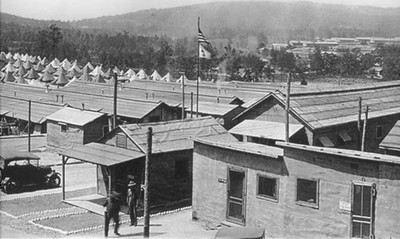 39th Infantry Brigade, an element of the 20th Division in formation at Camp Sevier (shown at right), outside of Greenville, South Carolina. In moving to Camp Sevier, it transferred key personnel to form the cadre for the newly formed 89th
39th Infantry Brigade, an element of the 20th Division in formation at Camp Sevier (shown at right), outside of Greenville, South Carolina. In moving to Camp Sevier, it transferred key personnel to form the cadre for the newly formed 89th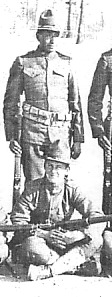 Infantry Regiment, which would join the 48th as part of the 20th Division. In the following months the whole Division had intensive training for shipment to France where it was to take up positions in the St. Die sector on the Meurthe River.in the Vosges of Eastern France in Lorraine. Part of that training included schooling from French and British commissions covering the new attack formations, liaison, artillery preparation, and "aeroplane" communications. The Spanish Influenza epidemic ravaging the country in October and November took 14 victims of the Regiment in this period. However the war ended on 11 November, by which time only two of the Division units had actually sailed. Strangely, those two units were the Division Butchery and Mobile Laundry Companies! At least when the 48th was to arrive they would be well fed and be able to wash their uniforms.
Infantry Regiment, which would join the 48th as part of the 20th Division. In the following months the whole Division had intensive training for shipment to France where it was to take up positions in the St. Die sector on the Meurthe River.in the Vosges of Eastern France in Lorraine. Part of that training included schooling from French and British commissions covering the new attack formations, liaison, artillery preparation, and "aeroplane" communications. The Spanish Influenza epidemic ravaging the country in October and November took 14 victims of the Regiment in this period. However the war ended on 11 November, by which time only two of the Division units had actually sailed. Strangely, those two units were the Division Butchery and Mobile Laundry Companies! At least when the 48th was to arrive they would be well fed and be able to wash their uniforms.
(* for definition of these terms see bottom of page)
Between the Wars:
1919: The Regiment transitioned from a wartime to peacetime environment at Camp Jackson, SC. Here is an extract from a photo taken in March 1920.
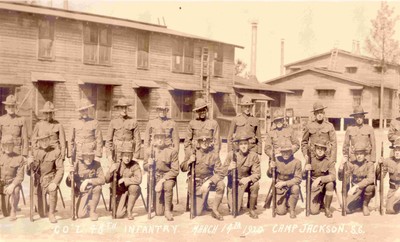 Later in 1920 the 48th was posted to Camp Harry J. Jones, Arizona, pictured further below. In the lower picture note the tents for billeting at the left rear, and the horse on the right by the white blotch or dust cloud in this 1916 photo. The 48th Infantry and 1st Cavalry Regiments were under the command of BG Malin Craig. They were there as the adjoining town of Douglas, AZ and Aqua Prieta, Mexico had been the site of skirmishes between Mexican revolutionaries and American troops, and might be again. (Tension between Mexico and the U.S. were high in the WW1 period)
Later in 1920 the 48th was posted to Camp Harry J. Jones, Arizona, pictured further below. In the lower picture note the tents for billeting at the left rear, and the horse on the right by the white blotch or dust cloud in this 1916 photo. The 48th Infantry and 1st Cavalry Regiments were under the command of BG Malin Craig. They were there as the adjoining town of Douglas, AZ and Aqua Prieta, Mexico had been the site of skirmishes between Mexican revolutionaries and American troops, and might be again. (Tension between Mexico and the U.S. were high in the WW1 period)
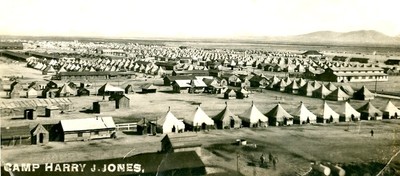
In 1921 the Army got big budget cuts, forcing it to release active duty soldiers. As a result, the 48th shrank, a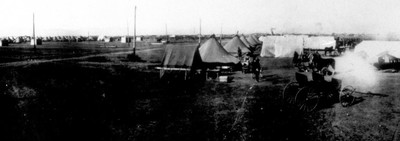 nd it was decided that those left should be absorbed back into the 9th Infantry Regt in San Antonio. (The original cadre to form the 48th came from the 9th in 1917) So the 48th moved to San Antonio, Texas, in preparation for demobilization.
nd it was decided that those left should be absorbed back into the 9th Infantry Regt in San Antonio. (The original cadre to form the 48th came from the 9th in 1917) So the 48th moved to San Antonio, Texas, in preparation for demobilization.
14 Oct 1921: The 48th was inactivated* at Camp Travis, Texas. Camp Travis was a sub-post of Ft. Crockett adjoining Galveston that had been designated as a demobilization center.
World War II:
27 February 1942: The 48th Infantry Regiment was re-constituted* in the Regular Army as the 48th Armored Infantry Regiment assigned to the 7th Armored Division.
2 March 1942: the Regiment was activated* at Camp Polk, Louisiana.
20 Sep 1943: under doctrine for armored divisions at the time, the regiment’s battalions were given separate designations as follows:
1st Bn as the 38th Armored Infantry Battalion
2nd Bn as the 23rd Armored Infantry Battalion
The remainder of the Regiment became the 48th Armored Infantry Battalion
Under these designations the Regiment had a very distinguished career in Europe starting as part of General Patton’s famous 3rd Army.
11 October 1945: War service completed, they were inactivated at Camp Shanks, New York.
(For a complete WW2 unit chronology, photos and maps, double click on the WW 2 button at the top of this page) The 7th Armored Division has its own web site at http://members.aol.com/dadswar/7ada.htm#units. The site contains pages for each of the Armored Infantry Battalions giving additional details of their WW 2 service and references.
In World War II, the units won the following CAMPAIGN PARTICIPATION CREDITS (When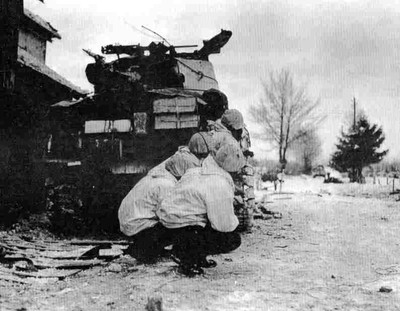 designated 38th Armored Infantry Battalion) for:
designated 38th Armored Infantry Battalion) for:
- World War II
- Northern France
- Rhineland
- Ardennes-Alsace
- Central Europe

DECORATIONS (for both when designated part of the 38th):
- Presidential Unit Citation (Army), Streamer embroidered ST.VITH
(38th Armored Infantry Battalion cited; DA GO 48, 1948)
(The Citation is shown at left on top of the Infantry shoulder chord;
the blue ribbon within the gold border. We wore it above the right
pocket on our greens. Thanks to Jim Chorazy 1962-63 for the image) - Belgian Fourragere 1940 (38th Armored Infantry Battalion cited;
DA GO 43, 1950) - Cited in the Order of the Day of the Belgian Army for action in the
ARDENNES (38th Armored Infantry Battalion cited; DA GO 43, 1950) - Cited in the Order of the Day of the Belgian Army for action at
ST. VITH (38th Armored Infantry Battalion cited; DA GO 43, 1950)
Korean War: Still designated as Armored Infantry Battalions of the 7th Armored Division, with the rest of the division they were activated 24 November 1950 at Camp Roberts, California. There they served as the cadre and Drill Instructors for newly inducted trainees into the Army. The 7th Armored Div adopted a Divisional training system, whereby each Battalion maintained its identity with trainees, but cooperated in various training areas through Divisional committees; General Subjects, Weapons, Tactics, Battle Indoctrination, and Rifle. In recognition of it good work in training, the unit received a "superior" in its annual inspection. Distinguished visitors to their training included Secretary of the Army Pace, and Gen. Mark Clark. When the Korean War ended, the units were inactivated on 15 Nov 1953 at Camp Roberts. (Camp Roberts is between San Francisco and Los Angeles on US 101)
Cold War: As companies of the 38th Armored Infantry Battalion they were relieved 15 Feb 1957 from assignment to the 7th Armored Division. Along with the 48th, 38th and 23rd Armored Infantry Battalions, they were consolidated to the 48th Infantry once again under the Combat Arms Regimental System.
1st Bn 48th Infantry:
15 Feb 1957, as H&HQ Co,1st Armored Rifle Bn, 48th Inf, it was assigned to the 1st Armored Div, and activated at Fort Polk, Louisiana.
23 Dec 1957: at Fort Polk, Louisiana was inactivated.
25 Feb 1958: relieved from assignment to the 1st Armored Div.
1 April 1958: the Bn was activated in Germany as a Seventh Army unit attached to the 4th Armored Group, and stationed at Taukkunen Barracks (Kaserne) in Worms on the Rhine River. The picture at left is of the Kaserne taken from the 3rd Floor of B Co barracks at that time. The barracks were built in the 1890s for the Hessian Infantry Regiment Nr. 118 (Prinz Carl). In 1961 the 1st ARB had a 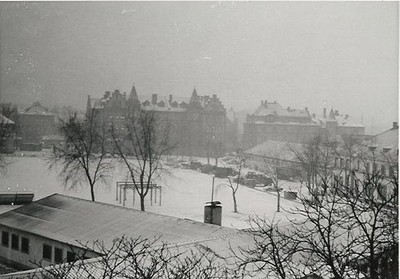 dual mission of defending the Rhine river crossing, and also guarding and assisting the evacuation on 7th Army dependants. While in Worms they made many practice swims across the Rhine in M-59’s and later M-113’s, assumedly under assumption the Rhine river bridges would be attacked in the event of war. The Bn. spent a lot of time at Grafenwoehr, Hohenfels, and also acted as Aggressors in the German Alps for E&E training for Army and Air Force personnel. In this process they even ran an Aggressor POW camp for brief periods of time!
dual mission of defending the Rhine river crossing, and also guarding and assisting the evacuation on 7th Army dependants. While in Worms they made many practice swims across the Rhine in M-59’s and later M-113’s, assumedly under assumption the Rhine river bridges would be attacked in the event of war. The Bn. spent a lot of time at Grafenwoehr, Hohenfels, and also acted as Aggressors in the German Alps for E&E training for Army and Air Force personnel. In this process they even ran an Aggressor POW camp for brief periods of time!
1 Sept 1963: reorganized and redesignated as the 1st Bn (Mechanized), 48th Infantry and co-located in Gelnhausen with the 2nd Bn of the 48th, 3rd Armored Division. In this reorganization under the "ROAD" concept Armored Division battalions were reduced from five companies to four, and no longer called Armored Rifle Battalions, but were called Infantry Battalions (Mechanized). (See Jack Falcone’s explanation of ROAD). Almost all of the members of the old 1/48th in Worms remained there and adopted a new designation of the 1st Bn, 39th Infantry, 3rd Brigade, 8th Infantry Division. The 1st Bn at Coleman Kaserne was filled by the transfer of the 2nd Bn’s D company. Personnel and equipment of D Co. 3/36th Infantry moved to Gelnhausen and became B Co. 1/48. Other men came from other parts of Germany, including a few from the old 1/48th at Worms.
16 June 1989: 1st Bn 48th Inf was inactivated and personnel redesignated 4/18th Infantry Regiment in Gelnhausen.
15 April 1996: Headquarters transferred to the U.S. Army Training and Doctrine and activated at Fort Leonard Wood, Missouri. At Ft. Wood, the 3rd Brigade’s 1st Bn 10th Infantry was inactivated, and personnel reflagged as 1st Bn 48th Infantry.
2nd Battalion 48th Infantry:
On 1 Oct 1957, According to the Army’s official lineage, Co. B of the 38th Infantry was re-designated as HQ and HQ CO, 2d Armored Rifle Battalion, 48th Infantry, assigned to the 3d Armored Division, and activated in Germany at Combat Command B’s Coleman Kaserne. How it was actually done on the ground was that when the 3rd Armored Division gyroscoped to Germany, the division’s 29th Armored Infantry Battalion was shipped on the USS Butner from New York to Bremerhaven and then on to Gelnhausen. There the 29th AIB (also named "Dragoons") was reflagged as the 2/48th Infantry. Coleman Kaserne was completed in 1936 and had housed a Wehrmacht anti-tank battalion (Panzer-Abwehrabteilung 9), until WWII started. When the US Army took it over, it added new American style barracks in addition to retaining the old German barracks.
The National Archives and Records Administration (NARA) has the original monthly history reports from each division to Seventh Army Headquarters for 1958. The 3rd Armored Division Reports are rather slim, but enabled the following 1958 chronology for the 2nd ARB, 48thInfantry to be extracted:
10 to15 March: 2/48 sponsors the 3AD Maurice Rose Trophy Matches, won by CCB.
19 March: CCB practice alert at 0400 hrs, 2/48 moved directly to Wildflecken Training Area.
? March: LTC Frank J. Kent to 2/48 (Bn Commander?)
1 April: 2/48 departed for Grafenwoeher to sponsor the Junior Camp Perry Rifle and Pistol matches and the USAREUR Championship Rifle and Pistol Matches.
1 to 4 May: continues training at Grafenwoeher
5 May: 2/48 returns to home station
18 July: The anniversary of the 2/48 was celebrated by the unit
11 August: Main elements of CCB depart for Grafenwoeher
? August: MAJ Raymond D. Barrett transfers to 2/48 from HHQ 3AD
1 September: 2/48 still at Grafenwoeher
13 to 14 September: 2/48 conducts Bn FTX (Field Training Exercise)
22 September: CCB returns to Gelnhausen from Grafenwoeher
28 November: CCB and attached units marched to Wildflecken in conjunction with a practice alert. (NARA Source: RG#338, Stock Area 290, Row66, Compartment 19, Shelf 6-7, Box54 in Seventh Army organizational records.)
Typifying activities of the battalion is the picture below, donated by Jim MacClay (former 3/33rd Armor). It is a copy of one in SPEARHEAD Newspaper in 1962. The caption reads "Moving to a new position during platoon-in-defense exercises at Hohenfels are APC’s from Co B, 2d ARB, 48th Inf. In the lead is track B-21 driven by Sp/4 Ralph Honor and commanded by PSGT Ernest T. Spinks."
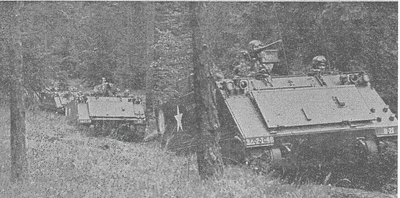
Equipment-wise the battalion had recently converted from M-59 to M113 Armored Personnel Carrier “tracks” or "APCs", but the “Four Deuces” (4.2" mortars) still had M59 APCs. The Scout Platoon replaced their M-38 jeeps with M151s with an M60 MG mounted on a stand behind the two front seats. A rifle company consisted of 3 rifle platoons with 4 M-113s each, and a mortar platoon with 3 81mm mortars. The Bn also had 3.5" bazookas, but they were replaced with 90mm recoilless rifles. The normal routine was continuous training and maintenance very similar to that outlined above for 1958. The highlights of each year were two weeks field training at Hohenfels in the summer, and 2 weeks at Grafenwoeher in the winter. In between, we were seemingly always in the field on maneuvers.
Under the ROAD reorganization, 2nd Armored Rifle Battalion was re-designated on 1 Sep 1963 as the 2d Battalion (Mechanized) , 48th Infantry and Combat Command B became 2d Brigade. Rick Mendenhall remembers this change and wrote "About our move to Gelnhausen all I remember is we moved all our belongings up there before going on maneuvers to either Graf or Hohensfeld. After the training was over we never went back to the Rock (Kirchgoens, home of the 38th Infantry in 3AD). D Co. 3/36 became B/1/48 the Army called it the ROAD program or Reorganization of Army Divisions. It dropped D Co. from all Battalions. If memory serves me right the other line companies came from the Delta company of the 1/36 and the 2/36 I’m not to sure about Hq. Company they filled the unit with troops from all over Germany,"
The 2/48, at near full strength, and with about 60 days advance notice, was deactivated in Sep 1983. Most of the men went to the 1/48.
3rd Battalion 48th Infantry:
Assigned to the Training Brigade at Fort McClellan, Alabama, 3/48 conducted gender integrated basic training. Fort McClennan was closed on May 20, 1999 per the The Department of Army’s Training and Doctrine Command (TRADOC) planned consolidation of FortMcClellan‘s training into Fort Leonard Wood’s existing training.
If you can help fill out this very sketchy information, please contact me.
Today: On 16 June 1989 the Regiment was reorganized under the United States Army Regimental System and transferred to the Untied States Army Training and Doctrine Command. The 1st Bn is now active at Ft Leonard Wood, MO. See the "48th Today" page of this site for details.
(Sources: INFANTRY, Part. 1: Regular Army, by John K. Mahon & Romana Danysh. In The Army Lineage Series. Office of the Chief of Military History, United states Army, Washington, DC: 1972. Pp. 669-74. Library of Congress Catalog No. 74-610219, Dewey Decimal System GOV REF 356.1109 M216. – WW1 posting from Order of Battle of the United States Forces in the World War (1917-19), Zone of the Interior, Vol. 3, Part 2, prepared by the World War I Group, Historical Division, Special Staff, U.S. Army, 1949. – United States Army in World War II, Special Studies, CHRONOLOGY 1941-1945, compiled by Mary H. Williams, Office of the Chief of Military history, Department of the Army, Washington, D.C. 1960, U.S. Govt Printing Office, Library of Congress Catalog Number 59-60002)
FURTHER REFERENCES
(from the U.S. Army Historical Center at: http://carlisle-www.army.mil/usamhi/Bibliographies/UnitHistories/inf/regt/48.doc
A Working Bibliography of MHI Sources:
- Sawicki, James A. Infantry Regiments of the US Army. Dumfries, VA: Wyvern, 1981. Pp.138-40. #603-1. 1981.Ref. General history of unit.
- Cole, Hugh M. The Ardennes: Battle of the Bulge. United States Army in World War II. Washington: Government Printing Office, 1964.
- The Lorraine Campaign. United States Army in World War II. Washington: Government Printing Office, 1950.
(1) Definition of terms
Constitute. To place the designation of a new unit on the official rolls of the United States Army.
Organize. To assign personnel and equipment to a unit and make it operative— that is, capable of performing its mission.
Inactivate. To place a Regular Army or Army Reserve unit that is not currently needed in the force structure in an inoperative status without assigned personnel or equipment for a limited period of time. The unit is transferred to the inactive rolls of the United States Army, but it can be activated again whenever needed. Its personnel and equipment are reassigned to one or more active units, but its historical records and properties are placed in storage. Upon reactivation, the unit retains its former history, lineage and honors, and it may retrieve its records and properties from storage. The term "inactivate" has been used only since 1921. Before that time, units either remained active or were removed from the rolls of the Army.
Reconstitute. To restore to the official rolls of the United States Army a unit that has been disbanded , demobilized, or had its federal recognition withdrawn. The reconstituted unit may have a new designation, but it retains its former history, lineage, and honors.
